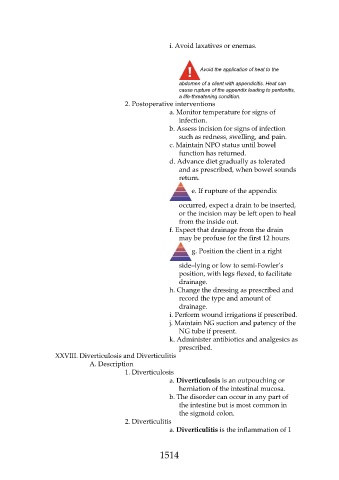Page 1514 - Saunders Comprehensive Review For NCLEX-RN
P. 1514
i. Avoid laxatives or enemas.
Avoid the application of heat to the
abdomen of a client with appendicitis. Heat can
cause rupture of the appendix leading to peritonitis,
a life-threatening condition.
2. Postoperative interventions
a. Monitor temperature for signs of
infection.
b. Assess incision for signs of infection
such as redness, swelling, and pain.
c. Maintain NPO status until bowel
function has returned.
d. Advance diet gradually as tolerated
and as prescribed, when bowel sounds
return.
e. If rupture of the appendix
occurred, expect a drain to be inserted,
or the incision may be left open to heal
from the inside out.
f. Expect that drainage from the drain
may be profuse for the first 12 hours.
g. Position the client in a right
side–lying or low to semi-Fowler’s
position, with legs flexed, to facilitate
drainage.
h. Change the dressing as prescribed and
record the type and amount of
drainage.
i. Perform wound irrigations if prescribed.
j. Maintain NG suction and patency of the
NG tube if present.
k. Administer antibiotics and analgesics as
prescribed.
XXVIII. Diverticulosis and Diverticulitis
A. Description
1. Diverticulosis
a. Diverticulosis is an outpouching or
herniation of the intestinal mucosa.
b. The disorder can occur in any part of
the intestine but is most common in
the sigmoid colon.
2. Diverticulitis
a. Diverticulitis is the inflammation of 1
1514

